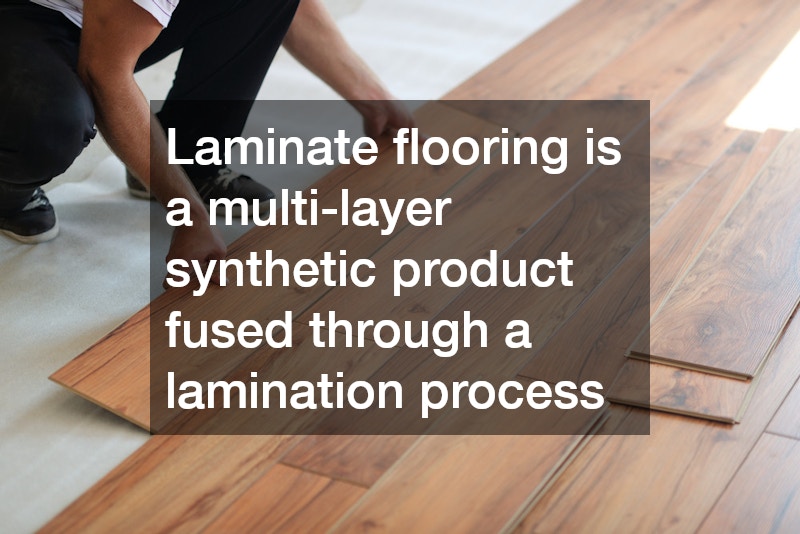In this guide, we explore everything beginners need to know about laminate flooring. Whether you’re considering a home renovation or looking for durable flooring options, laminate flooring offers a versatile and cost-effective solution. We will cover the basic concepts, benefits, installation, and maintenance of laminate flooring.
What is Laminate Flooring?
Laminate flooring is a multi-layer synthetic product fused through a lamination process. It often simulates wood (or sometimes stone) with a photographic appliqué layer under a clear protective layer. Unlike hardwood, laminate flooring is engineered to resist scratches and wear, making it suitable for high-traffic areas.
The core layer of laminate flooring is usually made of melamine resin and fiberboard materials. This composition gives laminate its strength and durability, allowing it to support heavy furniture and withstand foot traffic. Compared to hardwood flooring, laminate is a more budget-friendly option while still providing an authentic look.
A key differentiator of laminate flooring is its ease of installation, which can be achieved through a lock-and-click system. This design makes it a popular choice among DIY enthusiasts looking to revamp their living spaces without professional help. It is also adaptable to various room layouts, offering flexibility in design and pattern choices.
One of the most appealing features of laminate flooring is its resilience to wear and tear. Its top layer is crafted from a durable material that resists fading from sunlight exposure and the impact of daily usage. This makes laminate an excellent choice for homes with pets and young children.
In addition to durability, laminate flooring boasts a wide range of design possibilities. Advances in technology have enabled manufacturers to create highly realistic textures and patterns, mimicking the natural warmth of wood or the elegance of stone. Homeowners can select from numerous styles and colors to match their décor with ease.
Cost efficiency is another major advantage of laminate flooring, offering the look of expensive hardwood floors at a fraction of the price. Installation is typically quicker and more straightforward than other flooring options, reducing labor costs. Moreover, the laminate’s strong wear layer minimizes the need for frequent replacement, making it a sound long-term investment.
How to Install Laminate Flooring?
Proper preparation is crucial for the successful installation of laminate flooring. Start by measuring the area to determine the amount of flooring required, considering a waste margin for cuts and mistakes. Next, assess the subfloor conditions, ensuring it’s clean, dry, and level for optimal results.
Gather the necessary tools, such as a tape measure, saw, and spacers, to facilitate a smooth installation process. It’s recommended to acclimate the laminate planks to the room environment for at least 48 hours before installation. This step prevents expansion or contraction after installation, contributing to a stable floor.
Careful planning involves selecting the direction in which the planks will be laid to enhance the room’s aesthetic and functional aspects. Typically, running the planks parallel to the longest wall or toward a window can maximize the visual appeal. Taking the time to plan will ensure a seamless flow and professional finish to your new floor.
Begin the installation by laying down an underlayment to provide a sound barrier and cushion under the laminate flooring. Start the first row with a full plank, positioning it along your chosen starting line, leaving a gap between the planks and wall for expansion. Use spacers consistently around the perimeter to maintain this expansion gap.
Continue adding planks row by row, ensuring each piece locks securely with the adjoining plank using the click-and-lock system; this mechanism ensures a tight fit and prevents movement over time. As you progress, stagger the planks to create a more natural appearance and increase the floor’s structural integrity.
For the last row, measure and cut the planks to fit precisely. Remove the spacers after installing all planks, allowing the floor an adequate expansion gap. Finally, install baseboards and moldings to cover expansion gaps, providing a polished finish to your laminate flooring project.
How to Maintain Laminate Flooring?
Regular cleaning is key to preserving the appearance and longevity of laminate flooring. It’s best to sweep or vacuum frequently to remove dust and debris that can cause scratches. Use a damp mop for a deeper clean, ensuring the mop is slightly damp to prevent water damage to the floor.
Avoid using abrasive cleaners or steel wool pads, as they can scratch the protective layer of the laminate flooring. Opt for a cleaner specifically designed for laminate surfaces, ensuring it won’t leave a residue or streaks. Following these simple guidelines can greatly extend the life of your laminate floor’s appearance and functionality.
It is wise to quickly wipe up spills to prevent them from seeping into seams, which can cause warping or swelling. Utilize soft cloths or paper towels to blot liquids, rather than dragging or scrubbing. Keeping the floor dry ensures the laminate retains its pristine condition for years to come.
Preventive maintenance involves strategies to protect laminate flooring from damage. Place mats at entryways to catch dirt and moisture before it reaches the laminate floor. This simple step significantly reduces wear from rough particles carried in by footwear.
Use protective pads under furniture legs to prevent scratches and dents when moving items. Additionally, regularly rearrange furniture to distribute weight evenly and minimize indentation marks. These preventive measures ensure the floor maintains its structural integrity and aesthetic appeal over time.
Control the indoor climate by maintaining moderate humidity levels within the home. Excessive moisture or dryness can affect laminate flooring, making it prone to warping or gapping. Using a dehumidifier or humidifier can help keep the environment stable for your flooring.
Laminate flooring offers a practical and aesthetically pleasing solution for any homeowner. With proper installation and maintenance, it can provide lasting beauty and functionality. This guide has equipped you with the essential information to make informed decisions about using laminate flooring in your space.




